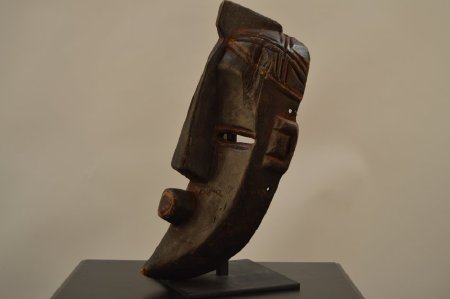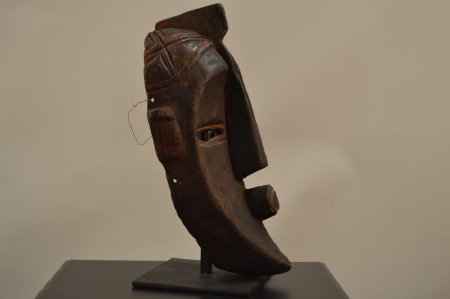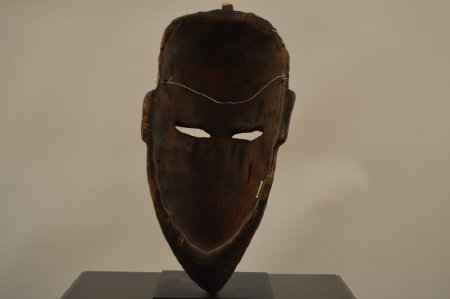Title:
Lwalwa Dance Mask
Object Name:
Mask, Dance, Lwalwa
Other Name:
Mask, Face
Place of Origin:
Lwalwa, Democratic Republic of Congo, Africa
Provenance:
Aboriginal Indigenous Art.
Lwalwa carvers are famous for their masks. The masks typically display a balanced composition, an enlarged angular nose, a protruding mouth and slanted eyes set under a deeply formed forehead. These sharply delineated features give Lwalwa art almost geometric appearance. The masks may be divided into four types: the nkaki, or manís mask, with a nose sculpted into a wide triangular panel that sometimes extends up to the forehead; the shifoola, a mask with a short, hooked nose; the mvondo, the nose of which is reminiscent of the nkakiís, but smaller; and finally the mushika or kashika, which represents a woman and which has a frontal crest. The shapes of the nose are modeled after different birds. The lips are narrow but protruding and thick; the eyes have openings in horizontal slits. On the temples they have a protuberance that represents tattooing. The masks had an important function in the bangongo dance of the hunting ritual.
Lwalwa carvers are famous for their masks. The masks typically display a balanced composition, an enlarged angular nose, a protruding mouth and slanted eyes set under a deeply formed forehead. These sharply delineated features give Lwalwa art almost geometric appearance. The masks may be divided into four types: the nkaki, or manís mask, with a nose sculpted into a wide triangular panel that sometimes extends up to the forehead; the shifoola, a mask with a short, hooked nose; the mvondo, the nose of which is reminiscent of the nkakiís, but smaller; and finally the mushika or kashika, which represents a woman and which has a frontal crest. The shapes of the nose are modeled after different birds. The lips are narrow but protruding and thick; the eyes have openings in horizontal slits. On the temples they have a protuberance that represents tattooing. The masks had an important function in the bangongo dance of the hunting ritual.
Description:
Oval—shaped wooden face mask, coming to a triangular—shaped elongated chin. Projecting triangular nose, narrow slit eyes with rectangular—shaped outlines. Concave face, set off from the forehead by a projecting browline with comb—like coiffure, coming to an elongated protruding point at top center and extending downwards from the high bridge of the nose to the temples and continuing to the bottom of the chin. Rectangular—shaped ears and protruding circular mouth. Entire surface covered in dark brown paint, or patina.
Collection:
Guy Mace Collection, (Turblex Company)
Material:
Wood W/Patina
Used:
Ritually Used
Technique:
Carving / Painting
Owned:
Art Department, MSSU
Accession#:
2015.2.6




